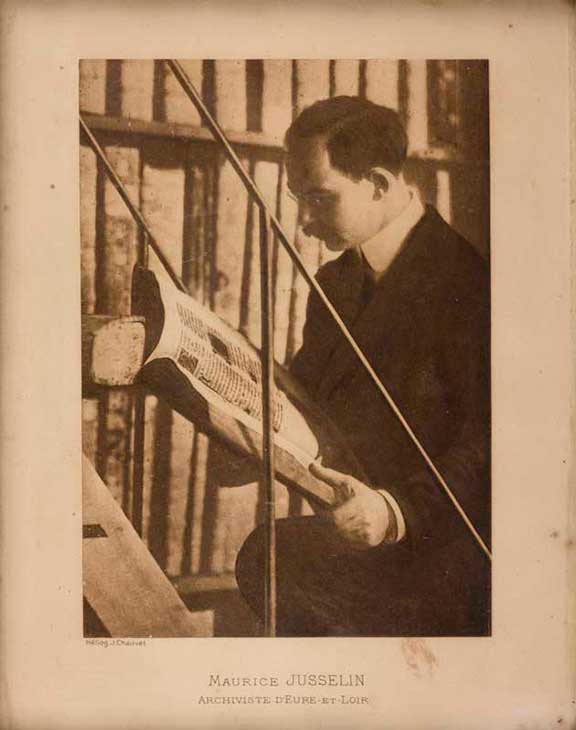Maurice JUSSELIN, eminent paleographer and great specialist in Tironian notes, could have become a renowned professor. Archivist for the Eure et Loir department and president of the Eure et Loir archaeological society, he finally turned his attention to the Chartrain region. He is the author of a large number of opuscules on the subject, too little known, but always perfectly documented. In fact, his bibliography is several pages long. For he has devoted himself entirely to his work, gathering and annotating precious documents, and devoting to his studies an erudition that never fails to amaze – his ‘footnotes’ sometimes taking up the bulk of the subject. He is known to be impartial and concerned only with the truth. Nothing is as interesting as his enlightened comments on the texts that make up Chartres Cathedral’s ‘legendary collection’.

« In 1432, Charles VII granted letters of grace to the city of Chartres, pointing out that its church was the oldest in the kingdom of France, that it had been founded by prophecy in honor of the Virgin before the incarnation of Christ, and that the Virgin had been honored in this church during her lifetime. The King did not deviate from Tradition as recorded in the Old Chronicle, which also inspired the writer of a memoir addressed to the Pope at the same time, in defense of the rights and freedoms of the Chartres church.
In 1475, a ruling by the Parliament of Paris listed the evidence provided by the opposing parties: the Bishop and Chapter declared that the Church of Chartres was “held, dictated and repputed the oldest in Christendom, founded in honor of the Virgin Mary and before the Incarnation of Our Lord Jhesucrist. … Founded before the Incarnation and in honor of the Virgin to come, as were and are all the histories and ancient cronisques of the said church, as otherwise“.
Finally, Pope Leo X’s bulls of January 1, 1517, granting indulgences to the faithful who make donations to help complete the enclosure of the choir begun by Jean de Beauce, still have the Old Chronicle as their source. It states that the Virgin Mary, who was to give birth, was venerated in the Chartres church before the birth of Christ by the inhabitants of the Chartres region and their count. This 1517 text is of considerable value, as it enables us to pinpoint the date at which the Traditions of the Chartres church suffered the most serious attack possible.
Manuscript 1027 of the Chartres library, from which the Vieille Chronique is copied, bears on folio 71 verso an addition in sixteenth-century handwriting which, because of its angular form, appears older. This interpolation, placed opposite the passage in the Chronique text which deals with the Traditions of the Chartres church, its foundation before the birth of Christ and the veneration of the statue sculpted by order of the Count of the Chartres region, claims to give and admit an absolutely new interpretation of Tradition. It states that the Druids, informed of Isaiah’s predictions, had a statue of the Virgo paritura sculpted and even sent deputies to Jerusalem to find out whether the Virgin prophesied by Isaiah had been born. Unfortunately, all these assertions were adopted and popularized. We find them in the Petit Traicté composé par Estienne Prévost, Official de Chartres, touchant la fondation et érection de l’Eglise -Nostre-Dame et cité de Chartres, printed in 1558, and in Rouillard’s Parthénie, printed in 1609. However, the Druids were ignored in the Middle Ages and did not flourish in Chartres, so they have no place in Chartres’ tradition, which is based on memories of Gallo-Roman times. These new ideas were inspired by reading the first editions of Caesar’s Commentaries, which, in Book VI, Chapter IV, speaks of the Druids. By placing the foundation of the church not during the Virgin’s lifetime, but before her birth, Vieille Chronique had prepared for this error. We can see the consequences for a tradition of the successive interpretations it undergoes.
The royal chancellery, which in all circumstances paid tribute to the merits and antiquity of the Chartres church, was not so quick to adopt the Druid legend that had emerged in the second quarter of the 16th century. In his letters of 1579, King Henri III merely recalled that the church had been founded in honor of the Virgin Mary, even before the birth of Christ, and, without mentioning the Druids, Louis XIII wrote in January 1638: “The antiquity, devotion and service of the cathedral church of Notre-Dame de Chartres have made it holy and venerable to all Christians, for it was born in the prophecies of the Virgin’s birth and the mysteries of our Redemption several centuries before the birth of the Redeemer“.
After the 17th century, criticism intervened, and as we did not yet have the means to follow the development of Tradition and find the historical sources of its allegations, there was much discussion, without result, because of it, sometimes denying it any value, sometimes seriously compromising it by exaggerating, with the intention of perpetuating it, the deformations it had undergone in the course of time, particularly the legend of the Druids.
Today, sixty centuries of solidly established history have given us broad visions of the development of mankind, and we feel at every moment that it is no longer possible to reduce everything to the end of our generation, and that a millennium brings only insensible changes to this eternal background from which emanate the inner life of man and the great guiding thoughts. Our clairvoyance, aided by patient research, leads us, without losing our way, into the life of the ages, to find truths that gradually present themselves to us in their entirety, clothed in a moving simplicity. The Traditions of the Church of Chartres, twice a thousand years old, contain within them some of these truths which predate written history, and which it is impossible to neglect without diminishing our past ».